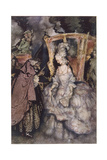

The book was an instant triumph, proving so successful that Rackham followed it up in 1920 with his second – and final – silhouette masterpiece, The Sleeping Beauty. The response to this double challenge was a master-stroke – the ‘Rackham’ for 1919, a retelling of Cinderella, would be illustrated throughout in silhouette, simultaneously showcasing an unexpected dimension of his work and taking advantage of the lower costs of black and white printing.


Rackham’s publisher, William Heinemann, also pioneered a new strategy to cater for true devotees – releasing a beautifully printed and bound limited ‘ edition de luxe’, numbered and signed by Rackham himself, alongside the standard trade edition.īut in the immediate aftermath of the First World War, the demand for such lavish and expensive books was uncertain, and Rackham feared that his style of illustration was falling out of favour in the face of modern artistic developments. The publication of ‘ this year’s Rackham’ was a highly anticipated event in the build-up to Christmas, and a carefully timed exhibition of the original artwork for his forthcoming book was held annually at the Leicester Galleries in London, to generate further excitement. During the first decade of the 20th century, Rackham was the uncrowned king of the thriving Edwardian gift-book market.


 0 kommentar(er)
0 kommentar(er)
